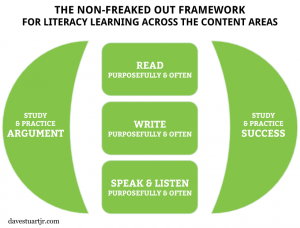
The Non-Freaked Out Framework (Figure 1) is really just a set of five imperatives. One goal governs them all: let's do increase the quantity and quality of these things, across the content areas.
“Framework” is probably a bad word for what it actually is. Maybe I should call them “The Non-Freaked Out List of Important Things to Become Good At” or “The Non-Freaked Out Approach to Prioritizing the Thousands of Things Classrooms Teachers Are Expected to Do in a Week.” But those are pretty long, and framework is pretty short, so I'm sticking with that. It should be obvious that there aren't any new ideas here; I'm after simplicity over originality, manageability over comprehensiveness, excellence at a few over mediocrity at many. If I can't hold something in my head as I plan lessons, improvise instruction, and tweak curricula, then you won't see me implement it consistently.
The hypothesis behind the NFO Framework is this: the better we get at teaching kids to argue, read, write, speak, and improve (that's the character bit), the more likely it is that our kids will flourish long-term.
The surest way to get better is through focused, deliberate practice. When I stretch my skills in these five focus areas, all while keeping an eye on results, I get better — noticeably so because I'm not “prioritizing” a thousand things. As I get better, my students grow more than they used to. If I want us to get better faster, I need to reduce the clutter in my curricula (ideal curricula are clutter free and content rich) so that there's maximum time and space for practicing these five things. Just a single wasted minute of class time every day — on clutter or fluff — amounts to 180 minutes wasted by the end of a school year. For me, that would be three whole class periods of fluff or clutter. I have to work against that.
One easy way to get an idea of whether or not you're currently giving your science or social studies or English or business students (and yourself) enough chances to practice these five lynchpin skills is to “Give Me a Number” pertaining to each one of them. Look back on the school year and spend an hour quantifying texts read (organized by type), public speaking tasks assigned (organized by type), writing assignment completed, and so on.
That's it, really. That's the Non-Freaked Out Framework, which is the most enduring thing I've created in four years of writing and thinking publicly about my teaching.
[hr]Thank you to Mike Schmoker, whose work has been seminal to mine, and whose interview I share here.
Leave a Reply